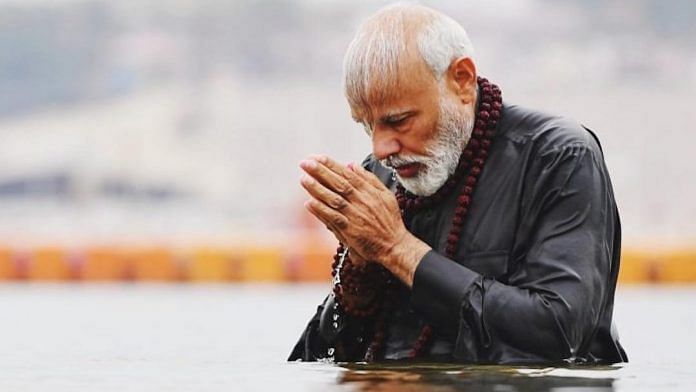As we near the 2019 Lok Sabha elections, the political significance of the Kumbh Mela becomes more and more apparent.
The last purna or full Kumbh Mela held at Prayagraj was in 2013. The chief minister at the time was a young Akhilesh Yadav. A reported 10 crore visitors flocked to the Maha Kumbh then. The arrangements were no doubt very impressive. Akhilesh Yadav earned well-deserved universal acclaim for his efforts. But he was not returned to power in 2017. The Samajwadi Party was reduced from 224 to 47 while the BJP, in a spectacular reverse swing, went from 47 to 312, bringing Yogi Adityanath to power.
This year’s festival, from 15 January to 4 March 2019, is actually the ‘ardha’ or half-Kumbh Mela. No matter. More than 12 crore (the entire population of Japan) people are expected to attend it. The makeshift Kumbh village, spread across some 45 sq km is half as large as the conurbation of Prayag itself. Having been to both the Kumbh melas, I can say this Kumbh was far cleaner, safer, and better organised than the one in 2013. Amenities, infrastructure, toilets, police presence—all had improved significantly.
Also read: BJP leaders can’t be faulted for rushing to Kumbh Mela, they would be foolish not to
The water, diverted straight from the Bhagirathi, was clean and refreshing. As I plunged in for the dip, I let go of all thoughts, feelings, hopes, anxieties, expectations, recriminations, and regrets. There was a magical sense of release, peace, and exhilaration. Some special force of faith or curiosity had brought visitors from all over India and abroad to his huge and holy gathering.
By pure coincidence, I discovered that Prime Minister Narendra Modi was expected at the Kumbh on 24 February, the very next day. He had inaugurated the Kumbh at its start, but now was back as a pilgrim.
Images of Modi in black, with rudraksha beads, offering obeisance, chest deep in the river waters, splashed across the media. The prime minister as a humble pilgrim and penitent. But there also were accompanying images of Modi draped in saffron, with the horizontal Shaivite marks on his forehead, offering aarti to the confluence of rivers with a lamp shaped like a hooded snake. Here he seemed triumphant rather than penitent. Together the two were tell-tale in their political possibilities: Modi as supplicant, seeking blessings; Modi as triumphant possibly winning a second term. Whatever the outcome, his visit changed the way I perceived the Kumbh.
This was not because he had sought to gain political capital from his pilgrimage. Some made the erroneous claim that he was the first PM to go to a Kumbh. Quite fatefully, Indira Gandhi had also been in here 1977, but it had not helped save her prime ministership. She was swept away in the tremendous surge in favour of the Janata Party after her disastrous Emergency. Earlier, as the newly elected prime minister of India, in fact, a day after assuming office on 25 January 1966, Mrs Gandhi had visited Prayag. She had made the special pilgrimage to her ancestral city to immerse the ashes of former PM Lal Bahadur Shastri. That act of faith and homage to a popular leader dead before his time had earned her the nation’s respect. In 1977, however, the wheel of fortune did not spin in her favour.
In contrast, in 2013, the Dharma Sansad – the gathering of Hindu saints and religious leaders at the Kumbh – had all but endorsed Narendra Modi for PM. He won with an impressive majority. As I left Prayag, I wondered what the coming months held in store for him. Would he be re-elected?
What had the Kumbh to do with it? Why should we look at it with a political lens? Wasn’t there any scope for pure spirituality in a society like India?
Also read: This is how the Kumbh Mela looks from the sky
The Kumbh, though primarily a spiritual experience, is also so much more. For one, its economic benefits are staggering, not only in terms of the government money spent, but also the immense sums of money earned and revenue generated. The travel and tourism industry, particularly, benefit immensely, with taxi and hotel operators earning in these six weeks more than what they might during the rest of the year.
Nearly 6 lakh jobs were created in this period because of the Kumbh. Our boatman told me that there were 4,500 families of their community earning a livelihood because of the festival. After the mela, less than 500 would be left, the others returning to their villages and towns.
That’s when it became clear to me that the political upshot of the Kumbh would be powerful, however indirect. Satisfied pilgrims would go back with a good impression of both CM Yogi Adityanath and PM Modi. Indeed, both were present on every poster at prominent street corners. The state had also seen tangible improvement.
Also read: 2019 Kumbh Mela is the costliest ever with a budget of Rs 4,200 crore
Cleanliness, prosperity, and regulation are so much more visible; the roads and highways are in better shape too. There is a sheen to Uttar Pradesh that would have been unimaginable earlier. Like me, the 12-crore plus visitors are voters as well. They would see for themselves what Modi had accomplished. The goodwill generated would turn into votes. This was the deeper political significance of the Kumbh.
Of course, some things never change in Uttar Pradesh. Most cars, regardless of age or make, identify their owners as ‘Advocate’, ‘DIG’, ‘Party Convenor’, ‘MLA’ and so on. Even a humble Maruti 800, missing one of the side windows, has a ‘Press’ sticker on its windscreen. Clearly, every ‘nobody’ in UP is still a ‘somebody’.
The author is a Professor and Director at the Indian Institute of Advanced Study, Shimla. His views are personal. His Twitter handle is @makrandparanspe



